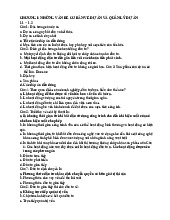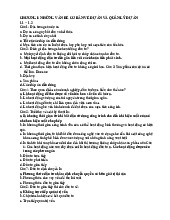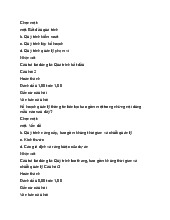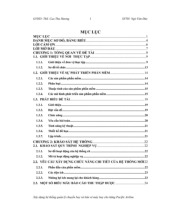






Preview text:
lOMoAR cPSD| 59671932 Glossary Project Management Terms and Definitions Course 5 A
Acceptance criteria: The checklist the project manager uses to decide whether a story is done
Adaptation: Adjusting project, product, or processes to minimize any further deviation or issues; one of the three pillars of Scrum
Agile Manifesto: A collection of four values and 12 principles that define the mindset that all Agile teams should strive for
Agile project management: An approach to project and team management that embodies “agility” based on the Agile Manifesto
Ambiguity: A state where conditions and root causes of events or circumstances are unclear, leading to
the possibility of misunderstanding B
Backlog refinement: The act of keeping the Backlog prioritized, estimated, and described so the Scrum Team can operate effectively
Burndown chart: A visual that measures time against the amount of work done and amount of work remaining
Business agility: Refers to incorporating Agile principles into the wide sphere of management
Business collaboration: The concept that collaborating with customers gets critical business information
to the team immediately, allowing them to adjust and adapt new information instantly; one of the four
themes of the Agile principles lOMoAR cPSD| 59671932 C
Capacity: The amount of work a team can handle in a given amount of time
Case studies: In-depth, data-driven analyses of a business, community, or organization
Change control board: A formal and rigorous process to manage any changes to requirements
Change management: The process of getting people to adopt a new product, process, or value system
Coaching: A two-way communication style aimed at influencing and developing employees’ skills, motivation, and judgment
Complexity: Refers to the high number of interrelated forces, issues, organizations, and factors that would influence a project
Continuous integration and continuous refactoring: The Extreme Programming practice of merging
product changes into a shared version several times a day in order to get quick feedback on the quality of the code or product
CSV file: A file type that holds a spreadsheet’s data; stands for “Comma Separated Value” because it uses commas to separate values
Cynefin framework: A framework used for measuring project complexity; pinpoints five sections of
complexity that various projects may fall into: obvious, complex, complicated, chaotic, and disorder D
Daily Scrum: A brief meeting of up to 15 minutes that takes place every day of the
Sprint to inspect progress toward the goal; also called a stand-up
Definition of Done: An agreed-upon set of items that must be completed before a project or user story can be considered complete
Deliverable: A tangible outcome from a project
Development Team: In Scrum, the people who do the work to build the product; also called Developers
DevOps: An organizational and cultural movement that aims to increase software delivery velocity,
improve service reliability, and build shared ownership among software stakeholders lOMoAR cPSD| 59671932
Disciplined Agile Delivery (DAD): A hybrid approach that combines the strategies from various Agile
frameworks, including Kanban, LeSS, Lean Development, Extreme Programming, and Agile Modeling;
guides people through process-related decisions and helps develop a scaled Agile strategy based on context and desired outcomes E
Empiricism: The idea that true knowledge comes from actual, lived experience
Epic: A group or collection of user stories
Extreme Programming (XP): A methodology that aims to improve product quality and the ability to
respond to changing customer needs; takes best practices for the development process to extreme levels F
Five values of Scrum: The core values that guide how Scrum Teams work and behave: commitment,
courage, focus, openness, and respect
Flow: A core principle of Kanban that aims to maximize efficiency I
I.N.V.E.S.T: Acronym for the criteria each user story should meet; stands for: independent, negotiable,
valuable, estimable, small, and testable Incremental: Describes work that is divided into smaller chunks that build on one another
Influencer: Someone who is able to lead and influence others to change their behaviors, hearts, and
minds to produce meaningful, sustainable results
Inspection: A timely check toward the outcome of a Sprint Goal to detect undesirable variances; one of the three pillars of Scrum
Iterative: Refers to repeating cycles of delivery K lOMoAR cPSD| 59671932
Kanban: A methodology that provides visual feedback to everyone who might be interested in the status
of the work in progress; displays the progress of a project as “to do,” “in progress,” and “done” L
Large-Scale Scrum (LeSS): A framework that aims to maximize the Scrum Team’s ability to deliver value
and reduce waste in larger organizations
Lean: A methodology in which the main principle is the removal of waste within an operation M
Managing: The act of overseeing the work of others; can include onboarding and orienting new
employees, conducting meetings, delegating tasks and assignments, monitoring progress and
performance against those tasks, making decisions, and dealing with conflicts
Minimum viable product (MVP): A version of a product with just enough features to satisfy early customers
Mission: A short statement that stays constant for the team throughout the project and gives them something to work toward O
Organizational culture: Describes shared workplace values and shows up in people’s behaviors,
activities, the way they communicate, and how they work with each other P
Pair Programming: The XP practice that refers to when two team members work together at the same time on one task
Product Backlog: The single authoritative source for things a team works on; contains all of the features,
requirements, and activities associated with deliverables to achieve the goal of the project
Product Goal: The desired future state of the product; can serve as a target for the Scrum Team to plan against lOMoAR cPSD| 59671932
Product increment: What is produced after a given Sprint
Product Owner: In Scrum, the role responsible for maximizing the value of the product and the work of the team
Product requirements document: A document that lists the scope and requirements of the project; used
in Waterfall project management
Product roadmap: A visualization or document that provides a high-level view of the expected product,
its requirements, and an estimated schedule for reaching milestones
Product vision: Defines what the product is, how it supports the customer’s business strategy, and who
will use it; makes clear what outcomes the team is responsible for and where their boundaries are R
Relative estimation: A comparison of the effort for a task to the effort for another task
Releasable: Refers to when the team has developed a minimum viable product of a given feature or requirement
Release plans: Indicates the approximate date when the team is expected to release and deliver certain
features to the customer or user; contains a release goal, the list of Backlog items, an estimated release
date, and any other relevant dates that impact a release
Requirements: Conditions that must be met or tasks that must be finished to ensure the successful completion of the project
Retrospectives and continuous learning: Refers to striving continuously to learn and adapt to what’s
working and what’s not; one of the four themes of the Agile principles S
Scaled Agile Framework (SAFe): A Lean-Agile scaling framework that combines concepts from Kanban,
Scrum, Extreme Programming (XP), DevOps, and Design Thinking methodologies; puts the goal of
delivering value above all else
Scrum: A framework for developing, delivering, and sustaining complex products lOMoAR cPSD| 59671932
Scrum Master: In Scrum, the role responsible for ensuring the team lives Agile values and principles and
follows the processes and practices the team agreed to; shares information with the larger project team
and helps the team focus on doing their best work
Scrum of Scrums: A technique for integrating the work of multiple, smaller Scrum Teams working on the same project or solution
Solution Design Sprint: An entire Sprint spent working solely on the solution design
Spotify model: The Spotify organization’s version of the Agile approach; focuses on culture, team
autonomy, communication, accountability, and quality to increase agility
Sprint: A timeboxed iteration where a planned amount of work is done
Sprint Backlog: The set of Product Backlog items that are selected to be completed during the upcoming Sprint
Sprint Planning: Refers to when the entire Scrum Team comes together to map out what will be done during the Sprint
Sprint Retrospective: An essential meeting of up to three hours for the Scrum Team to take a step back,
reflect, and identify improvements about how to work together as a team
Sprint Review: A meeting with the entire Scrum Team where the product is demonstrated to determine
which aspects are finished and which aren’t
Stacey Matrix: A framework developed to help project managers identify the complexities of their
environment so they can adapt their style of decision-making; enables a project manager to consider the
knowns and unknowns within their project based on implementation and requirements
Story points: A method for estimating user stories, tasks, and backlog items by assigning a point value based on effort and risk T
T-shirt sizes: A way to estimate what is needed for a work effort in terms of time, budget, and energy by
categorizing it as XS, S, M, L, XL, or XXL
Team dynamics and culture: Refers to creating an effective team culture that is inclusive, supportive, and
empowering; one of the four themes of the Agile principles
Three pillars of Scrum: The foundational concepts on which Scrum is based: transparency, inspection, and adaptation lOMoAR cPSD| 59671932
Timebox: A Scrum concept that refers to the estimated duration for an event
Transparency: Making the most significant aspects of the work visible to those responsible for the
outcome; one of the three pillars of Scrum U
Uncertainty: A lack of predictability or high potential for surprise
User story: A short, simple description of a feature told from the perspective of the user V
Value delivery: Refers to delivering the work as quickly as possible to get feedback and mitigate time
risk; one of the four themes of the Agile principles
Value roadmap: An Agile way of mapping out the timelines and requirements for the product- development process
Velocity: A measure of the amount of work a team can take on during a single Sprint
Volatility: The rate of change and churn in a business or situation
VUCA: The conditions that affect organizations in a changing and complex world; stands for volatility,
uncertainty, complexity, and ambiguity W
Waterfall project management: A project management methodology that refers to the sequential or linear ordering of phases
Work-in-progress (WIP) limit: A constraint on how many work items are actively being worked on at any given time




